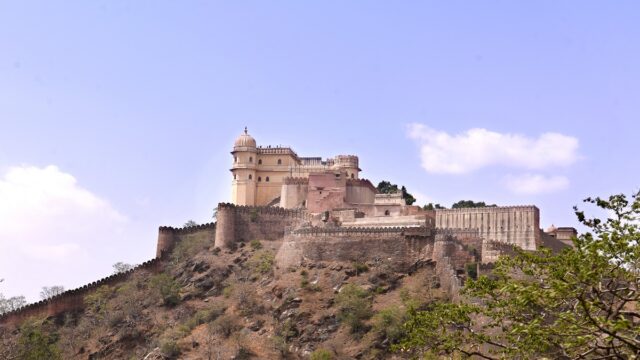Eight-abreast, it is repeatedly heard, is the number of horses the Great Wall of India (second only to the one in China) can accommodate across its width. That measure registers little until you physically trudge up to the top of the Fateh Prakash Mahal, also referred to as Badal Mahal, for a wind-swept view of what lies beneath. An impregnable 36-kilometre-long fortification that encloses within its massive girth a host of temples, dams, settlements, large swathes of wilderness, and not least, the place of birth of Mewar’s most legendary ruler, Maharana Pratap Singh. Built in the 15th century by Rana Kumbha, this UNESCO World Heritage Site exemplifies Rajasthan’s military hill architecture, and is home to a storied history and multi-layered heritage.
Located at the end of a two-hour drive from Udaipur, Kumbhalgarh Fort is by far one of the region’s top attractions, and not to be missed. A mostly well-tended road slices through an undulating Aravalli countryside replete with thor and dhok, past sleepy hamlets, bustling little towns, seasonal rivulets, and dammed reservoirs, to bring you here. Should the need arise, eateries and resorts are aplenty along the way, as are gas stations and mechanics. The foliage gets denser and the incline sharper in the last quarter of the stretch before the extraordinary fortress comes into view. The car park and ticket window are just outside Ram Pol, the main entrance, from where the fort walk also commences.

Visitors are ushered through several gates on their way to the top of the fort, notably Bhairon Pol, Neemboo Pol, Chaugan Pol (where the top khana is located) and Bagda Pol. It is beyond this last gate that the royal residences and stables of the erstwhile rulers of Mewar lie. The Kumbha Mahal hosts the section where Maharana Pratap was born, while Badal Mahal was a later addition built by Rana Fateh Singh in the 19th century. Embellished with lattice-work windows and wall paintings, this palace provides some of the most breathtaking views of India’s longest peek-a-boo playing wall and the Kumbhalgarh Wildlife Sanctuary beyond.
Visible from up here are a few of the 90 still extant (but mostly inactive) Hindu and Jain stone temples of the 360 that once dotted the fort’s expansive grounds. The Neelkanth Mahadev Temple is the most striking and houses a five-feet-tall shivling in its sanctum. A majestic domed, double-storied Yagyashala mounted on a high platform reached by a flight of steps stands next to this, beyond which is the towering shikara of a Parsvanath Temple, honouring the 23rd Tirthankara. All these temples are easily accessed from Ram Pol, including the Laxmi Narayan and Ganesh temples located to the left of the main entrance.

Detours
To make the most of a visit to Kumbhalgarh, veer left at Lausing on the return to Udaipur, and head towards Haldi Ghati, the narrow mountain pass where the eponymous battle between Maharana Pratap and the Mughals was fought in 1576. Stop by en route at Baleecha to see the memorials honouring the iconic ruler and his dearly loved horse Chetak, across the road from each other. A privately held museum dedicated to Maharana Pratap is located in close proximity to the two. A visit to the Shrinathji Temple in Nathdwara, an immensely popular pilgrimage centre located a mere 14 kms beyond Haldi Ghati, can also be considered.

Other Activities
Walk The Wall: Adventure seekers can consider a day-long guided hike atop India’s longest wall. Please note, this is not to be attempted unsupervised.
Kumbhalgarh Wildlife Safari: Jeep safaris can be availed between 6AM-9AM and 3PM-4.30PM. The safari entry is located on the road to Ranakpur, a kilometre beyond the Maharana Pratap circle near the fort. Expect to see sloth bears, panthers, wild boar, hyenas, and jackals; Golden Orioles, Asian Paradise Flycatchers, and Indian Pitta.
Zip-lining: For those looking for an adrenaline rush, an adventure camp located in close proximity of the fort offers zip-lining experiences.
Information Box
Dos & Don’ts: For an enriching experience, hiring well-informed, government authorised guides (upwards of ₹1,050 / full day / 5 pax) is recommended. Please note that the uneven path up is marked by steep stretches and several flights of stairs; wear sturdy footwear and carry drinking water.
Connectivity: At 84 kms, Udaipur is the closest airport, rail and road head.
Best season: Winter




